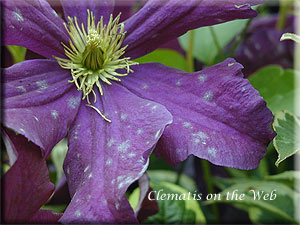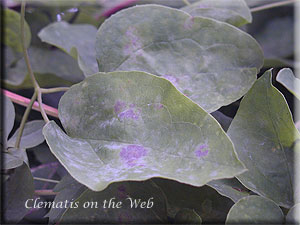Powdery Mildew
Types affected
Members of the American subgenus Viorna and especiallyC. texensis and its hybrids e.g. ‘Rooguchi’, ‘Duchess of Albany’, Etoile Rose’ are most susceptible to this disease. Some viticella cultivars as well as certain large flowered hybrids such as ‘Star of India’, ‘Blekitny Aniol’ and ‘Romantika’ are also highly susceptible.
Symptoms
Stems and foliage are mostly affected but in some of the examples quoted, flowers can also be heavily attacked.During the early stages of development, green parts take on a violet colouration. As infection progresses, the plant surface becomes covered in a white layer as masses of spores are produced by the fungus. Apart from the unattractive appearance that results, the disease results in a general weakening of the plant but not usually in outright death.

Powdery mildew symptoms on a flower
© Ian Lang

Powdery mildew symptoms on foliage
© Szczepan Marczynski
Conditions for disease development
The disease is favoured by warm, humid, conditions but is discouraged by rainy weather. It is prominent in localities where there is little air movement, where plants are grown in the shade and where high night humidity occurs. Powdery mildew outbreaks can, however, vary from season to season without there being obvious differences in the weather.
Control Methods
Provide conditions which do not favour the development of the disease. Ensure there is sufficient air movement and try to avoid watering in the evening to prevent humidity build-up. Remove and destroy all infected plant material in the autumn.
Under garden conditions, the disease can be kept under control by a well-managed fungicide spray programme. Start spraying known susceptible cultivars early in the season before symptoms appear. For northern Europe this would be round about May. If you know from past experience when the very first symptoms appear, then start spraying 3 weeks before this. Follow label recommendations but a total of three sprays applied at 2-3 weekly intervals should be sufficient to keep the disease under control. If not, then continue spraying longer and shorten the interval to 2 weeks.
Fungicides which are effective against powdery mildew can be broadly placed into 4 groups:
- Sulphur: Sprays will leave a visible spray deposit on the plants and if applied in hot weather, may cause burning of the foliage. Not liable to resistance development.
- Oil-based sprays e.g. ‘Sunspray’: Should not be used in combination with sulphur sprays. Not liable to resistance development.
- Products containing the active ingredients fenarimol, myclobutanil, triadimefon, tebuconazole, flutriafol, tebuconazole, penconazole: No more than 3 consecutive sprays of products in this group should be applied so as to prevent resistance.
- Products containing the active ingredients azoxystrobin, trifloxystrobin, kresoxim-methyl: No more than 3 consecutive sprays of products in this group should be applied.
When using fungicides for the first time, it is always wise to check that the sprays do not cause leaf scorching or other adverse effects on some cultivars.
Text ©2007 Paul Margot